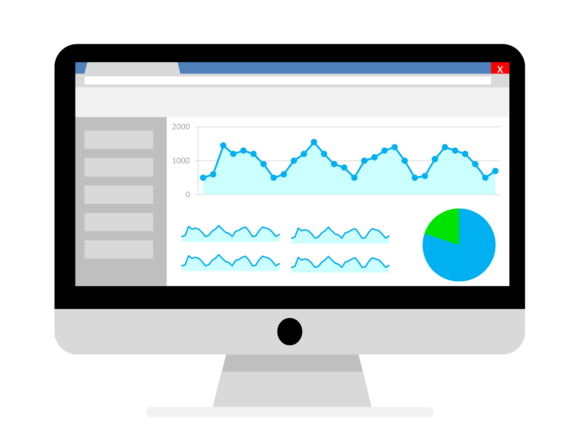Part 1: Analytics Metrics, 101
Have you ever been asked to use Google Analytics to do a report, but haven’t gotten past the first screen? With all the acronyms, charts, and graphs, the data can be overwhelming. This three-part series about Analytic Metrics will define some of the most essential metrics for understanding how your website is performing.

Pageviews
Definition: An instance of a page being loaded by a browser.
Translation: Every time one of your website visitors lands on a new page, that page gets a pageview. It’s common to see your homepage with the highest number of pageviews, since that’s the page most people use to enter your site. This is a great metric because it essentially tells you the most popular pages on your site. Use this information to prioritize which pages might need updated information or a redesign.
Where Can I See This Metric? Select AUDIENCE in the left navigation, then click Overview. If you want to see more Pageview information for specific pages, select BEHAVIOR in the left navigation, select Site Content, then All Pages.
Sessions
Definition: The number of times your visitors have been to your site (unique sessions initiated by all your visitors). If a user is inactive on your site for 30 minutes or more, any future activity will be attributed to a new session. Users that leave your site and return within 30 minutes will be counted as part of the original session.
Translation: We want people to come back to the website, right? Sessions show exactly how many separate visits your site received. It doesn’t matter what they did on the site or how they got there, this metric adds up the unique sessions. This allows you to see how many times your site has been visited during your selected date range. Note that since sessions are tracked through browser cookies, the metrics can be skewed a bit if users block cookies, clear their cookies, or start sessions within another device or browser.
Where Can I See This Metric? Select AUDIENCE in the left navigation, then click Overview.
Average Session Duration
Definition: The average session duration is calculated by (all sessions in seconds)/(number of sessions).
Translation: How long on average are your visitors staying on your site? If people are getting to your site, but aren’t spending much time on the site, it could mean your site doesn’t have what they are looking for or there isn’t enough content on the site. Keep in mind that people spend less time on websites when visiting on a mobile device, especially if your site isn’t mobile-friendly.
Where Can I See This Metric? Select AUDIENCE in the left navigation, then click Overview.

Bounce Rate
Definition: The percentage of single-page sessions (i.e. sessions in which the person left your site after only viewing a single page from the entrance page).
Translation: Imagine you are in a hallway lined with doors that are closed and each door represents a different website. You’re not sure what door (website) is the correct one, so you open one to check it out. When you open it you see that it wasn’t what you were looking for, close the door, and move on to the next one. That exact situation impacts the bounce rate. A Bounce Rate is a percentage, and in this case, the lower the number, the better it is. The more often visitors enter your site and immediately leave, the higher the Bounce Rate percentage grows.
Are you a visual learner? Kissmetrics created an infographic that breaks down what a Bounce Rate is in more detail, check it out here.
However, not all bounce rates are “bad” but having a high bounce rate on your homepage is definitely a negative and should be addressed. The exception to the rule is for mobile traffic and high bounce rates on specific pages like Contact Us. We expect mobile users to spend less time on a site; generally they are looking at a site while in transit to gather a simple piece of information, find what they are looking for, and leave. This is the same case for a user entering a site on a Contact Us page, finding the address or phone number they need, and exiting.
If your site is experiencing a high bounce rate, it could mean that your site’s content, design, or organization needs some attention. Make the information people are looking for easy to access (use what you learned by looking at your Pageviews) or consider revising your content (add more, get rid of industry jargon, or update the content).
Helpful hint: Did you know that you can adjust your website’s Bounce Rate parameters within Google Analytics? This technique is called Adjusted Bounce Rate. Google published a blog article on the subject and how to modify the code within your Google Analytics account. When you set up your website’s Adjusted Bounce Rate, you can define a time limit on what should constitute a Bounce Rate.
Exit Rate
Definition: The percentage of sessions (users) who exit a page that were previously on another page within the website.
Translation: People commonly misunderstand Exit Rate versus Bounce Rate. For example, a page may have an Exit Rate of 25% (4 sessions entered; 1 session exited). This compares how many people enter and exit the site (regardless of the number of pages they’ve already visited). The Bounce Rate is strictly based on a single-page session (25% bounce would be 1 of 4 sessions staying for that single page).
Where Can I See This Metric? Select AUDIENCE in the left navigation, then click Overview.
Have questions about how to read and react to your organization’s Analytics? Contact our team on Facebook, Twitter (@MediaG), or phone 248-687-7888, we can help translate the data and provide recommendations to improve your websites Analytics.


.png)
